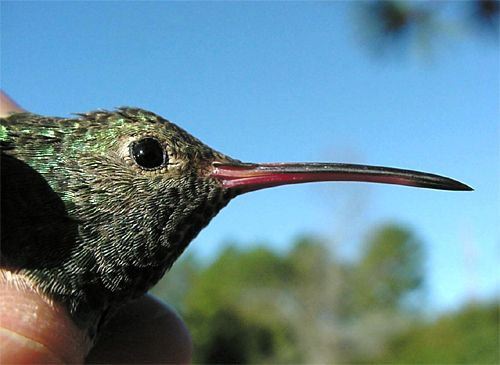 HOME: www.hiltonpond.org |
|||
|
No one can explain why Mexican hummingbird has made its home in S.C. |
|
All photos & text © Hilton Pond Center Staff Writer The first spotting of a buff-bellied hummingbird in South Carolina was serendipity. Cathleen Lee isn't a birder. She doesn't traipse through the woods looking for new species. But as a fifth-grade teacher at Lake Murray Elementary School in Lexington, she heard a science council presentation last month by hummingbird expert Bill Hilton Jr. of the Hilton Pond Center for Piedmont Natural History in Rock Hill. [Webmaster's note: Should be York, not Rock Hill.] Monday, Lee spotted an unusual-looking hummingbird at the front-porch feeder at her Red Bank home. She e-mailed Hilton with a description of the larger-than-normal creature with the brownish tail and the reddish-orange bill. Hilton read that e-mail Monday evening and was on the road before the first light Tuesday. He set up a trap at the feeder by 7:30 a.m. and spotted the bird about 10 minutes later. The hummer finally entered the trap about 8:30 a.m. That allowed Hilton to be sure his eyes weren't fooling him. He had the first buff-bellied hummingbird recorded in South Carolina. To say he was excited to document a new species in the state would be an understatement. Birders have been known to skip work and travel hundreds of miles to mark down a new species in their lifetime bird-sighting logs. Finding a species for the first time in a state is a birder's dream. "You might get a couple (new species) a decade," Hilton said. "As the list grows, it's harder and harder to spot a new one." arrival a mystery The buff-bellied hummingbird usually lives in Mexico's Yucatan peninsula. Hilton said they have wandered into several Gulf Coast states in recent years but never had been spotted in the Carolinas. He can only speculate on why the bird is here. Sometimes violent storms contribute to unusual bird sightings, but there haven't been any recently. Maybe the mild November across the Southeast encouraged a longer trip for the bird. Maybe habitat loss forced it to wander. "One of the neat things about this work is the more you do it, the more questions you come up with," Hilton said. To further knowledge on birds, last year Hilton started Operation Ruby Throat: The Hummingbird Project, which encourages schoolchildren to help survey hummingbird activity throughout the country and world. Hilton's recent presentation to teachers about the project led to this week's rare find. "It's very cosmic," Hilton said. "It's good that she was educated in advance and got back in touch with me." Lee also was amazed at the coincidence. She fills her front-porch feeder with the sugarwater to draw the birds strictly for entertainment purposes. "I don't claim to study them," she said. She suspected something unusual when the sugar-water level in her feeder dropped quickly last week. When she spotted the buff-bellied, she knew she had seen something unusual. She arranged for her teaching partner to cover for her in the classroom Tuesday morning so she could watch Hilton work. The students were told that their teacher might have found a new species for the state. When she arrived later in the day, the students cheered. "They were fired up," Lee said. Before the find, Lee had planned to incorporate Operation Ruby Throat into the spring curriculum. "What a wonderful introduction to the project," she said. Bird scientists try to capture birds rare to an area. They give the creature a quick inspection, take pictures and put an identification band on it before releasing it. The buff-bellied hummingbird captured Tuesday weighed 5.3 grams. The distance between the tip and the bend of the wing was 54.7 millimeters. The tail area was rusty brown, and the breast an iridescent green. Hilton suspects it was a female based on tattered tail feathers that hinted of nest-minding duties, but a definite determination of sex can't be done without an internal examination or a DNA test. "The bird surely knows," Hilton said, "but we do not." The bird flew off when freed and wasn't spotted again Wednesday or Thursday. It's anybody's guess whether that bird or another of its kind will ever be seen again in these parts.
Back to "This Week at Hilton Pond": First South Carolina Record Of A Buff-bellied Hummingbird |
|
Up to Top of Page Back to Vagrant & Winter Hummingbird Banding Back to What's New? Current Weather Conditions at Hilton Pond Center |
|
Make direct donations on-line through
Network for Good: |
|
|
LIKE TO SHOP ON-LINE?
Donate a portion of your purchase price from 500+ top on-line stores via iGive: |
|
|
Use your PayPal account
to make direct donations: |
|
 post questions for The Piedmont Naturalist |
Join the |
Search Engine for |
|
|



